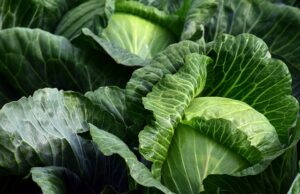Companion planting enriches cabbage growth, contributing to a robust garden. Examples of cabbage companions include chamomile, onions and garlic to name a few. Peruse the article below to learn more.
Introduction
Companion planting is a traditional gardening technique that involves planting different crops in close proximity to each other to promote mutual growth and protection. It’s based on the notion that certain plants can benefit others when planted next to, or very near to one another. Companion planting provides a more natural environment, allowing nature to maintain a balance, and plays a significant role in promoting the growth of healthy plants and vegetables, including cabbages. For cabbages, companion planting can help deter pests, enhance growth, and improve flavor. This time-proven practice is an integral part of sustainable agriculture, promoting plant health and yield.
Advantages of Companion Planting
General Benefits of Companion Planting
One of the key benefits of companion planting is pest control. Certain plants release chemicals from their roots or aerial parts to hinder or repel pests, safeguarding neighboring plants in the process. A prime example is the marigold flower, which emits a fragrance that acts as a natural deterrent against a wide range of insects. This protective shield offers defense to the plants in its vicinity.
Another significant advantage of companion planting is the maximization of space. This is particularly beneficial in small garden settings. By planting crops that enjoy similar light conditions yet have different growth habits or rates, gardeners can utilize the available space more effectively. For instance, planting a tall, sun-loving plant next to a low, shade-tolerant plant can lead to higher yields in the same garden footprint.
Lastly, companion planting promotes plant health and growth. Certain plant pairings have mutually beneficial relationships, with one plant supplying essential nutrients to the soil that the other plant needs. An example of this is the classic ‘Three Sisters’ planting of beans, corn, and squash. The beans fix nitrogen in the soil, promoting the growth of corn and squash. This symbiotic relationship results in healthier, more vigorous plants.
Companion planting, therefore, offers a variety of advantages that contribute to a more productive and sustainable garden. It’s a practice that extends beyond just cabbages and can be implemented across an array of vegetables and flowers for a thriving garden ecosystem.
Pest Control
Certain plant companions for cabbage can deter harmful pests through their inherent properties. For example, Thyme emits a strong fragrance that repels cabbage worms, which are common pests for cabbages. Rosemary and Sage also serve the same purpose, their strong scent confuses and deters pests from damaging the cabbage. Another excellent companion is the Nasturtium, a flowering plant that serves as a trap crop for aphids, keeping them away from the cabbage. Finally, Marigold is another powerful deterrent for many insects and nematodes due to its distinct scent. These plants, when grown alongside cabbage, can dramatically reduce pest infestation, thereby promoting healthier and more productive growth.
Promoting Plant Health
Some plants can significantly enhance soil quality, contributing to the healthy growth of cabbage. Legumes, including beans and peas, are known to fix nitrogen in the soil, a nutrient crucial for cabbage development. They do this through a symbiotic relationship with bacteria living in their roots, making them an excellent companion for cabbage. Another beneficial companion is Borage, an herb that adds trace minerals to the soil, enhancing its fertility and promoting robust cabbage growth. Chamomile is known for its ability to accumulate calcium, a nutrient that cabbages crave. Planting chamomile alongside cabbage can help meet the vegetable’s calcium requirements, promoting cell division and growth. Comfrey is another plant beneficial for soil health. Its deep roots bring up nutrients from the subsoil, enriching the topsoil and benefiting neighboring plants, including cabbage. By understanding the symbiotic relationships between plants and their impact on soil health, gardeners can foster a more productive and sustainable garden ecosystem.
Examples of Cabbage Companion Plants
Tomatoes
Tomatoes serve as a formidable ally in combating the diamondback moth larvae, a common pest afflicting cabbages. The strong scent of tomato plants acts as a natural deterrent, confusing the pests and making it difficult for them to locate and infest the cabbage plants. Additionally, tomatoes have a chemical in their leaves known as solanine which, when ingested by larvae, disrupts their feeding pattern and inhibits their growth. By planting tomatoes near your cabbage plants, you can effectively limit the population of diamondback moth larvae, ensuring the health and productivity of your cabbages. Care just needs to be taken that the tomato plants are not shading out the cabbage plants. Also, they should not be in the same bed as both plants are heavy feeders.
Beans
Beans are a powerhouse when it comes to enriching the soil with nitrogen, an essential nutrient for cabbage growth. As members of the legume family, beans harbor symbiotic bacteria known as Rhizobia in their root nodules. These bacteria have a unique ability to fix atmospheric nitrogen, converting it into a bioavailable form that plants can utilize directly. This process of nitrogen fixation replenishes the soil with this vital nutrient, promoting the lush, healthy growth of neighboring plants, including cabbages. The enhanced nitrogen levels in the soil can lead to more vigorous cabbage plants, larger yields, and an overall healthier garden. So, planting beans in your garden not only provides a harvest of delicious legumes but also plays a crucial role in nurturing the soil and promoting the growth and productivity of your cabbages.
Dill
Dill offers a unique benefit in a cabbage garden by attracting beneficial insects that serve as natural pest controllers. The bright yellow umbels of dill flowers are exceptionally appealing to a host of insects, including predatory ones like ladybugs, lacewings, and parasitic wasps. These insects primarily feed on common cabbage pests, such as aphids and cabbage worms. By attracting these beneficial insects, dill effectively creates a biological defense system against the pests that commonly afflict cabbage plants. As a result, it helps in maintaining a healthy, thriving cabbage garden. Therefore, including dill in your garden plan can be a boon to your cabbage patch while also adding to the overall diversity and ecological balance of your garden ecosystem. Since dill grows quite tall care has to be taken it is not shading out the cabbage.
Yarrow
Yarrow is another great companion plant for cabbage due to its ability to attract beneficial insects and its reputation as a general plant health promoter. Yarrow’s small, dense clusters of flowers are a magnet for predatory insects and pollinators alike. Ladybugs, hoverflies, and parasitic wasps, which prey on common cabbage pests, are particularly attracted to yarrow. This helps maintain a natural balance, reducing the need for synthetic pesticides. Additionally, yarrow is known to accumulate nutrients from deep within the soil and bring them to the surface, thereby improving soil fertility. This can result in healthier, more vigorous growth of cabbage plants. Hence, incorporating yarrow into your cabbage garden can not only boost the health and productivity of your cabbages but also contribute to the overall sustainability of your garden ecosystem.
Carrots
Carrots are an excellent companion for cabbages in the garden. The delicate, feathery foliage of carrots can be beneficial for cabbages in several ways. Firstly, the carrot’s foliage can provide a sort of ground cover that helps to keep the soil moist and prevent weed growth, thereby indirectly benefiting the cabbage plants. Secondly, carrots and cabbages do not compete for nutrients, as they require different nutrient profiles. This allows them to coexist harmoniously without hindering each other’s growth. Lastly, the scent of carrot foliage can confuse and deter cabbage pests like the cabbage root fly, reducing the likelihood of pest infestations. Therefore, integrating carrots in your cabbage garden can enhance soil health, optimize nutrient use, and provide a natural form of pest management, contributing to a more productive and sustainable garden ecosystem.
Onions
Onions make a significant companion plant for cabbages, providing several advantages in the garden. Firstly, the pungent scent of onions can act as a natural deterrent for many pests that plague cabbage, such as cabbage worms, aphids, and cabbage loopers. This can reduce the need for chemical insecticides, promoting a healthier, more organic garden. Secondly, onions, with their shallow root system, do not compete with cabbages, which have a deeper root system, for nutrients. This allows both plants to flourish without hindering each other’s growth. Lastly, onions have the added benefit of improving the flavor of cabbage when grown in proximity. Therefore, incorporating onions into your cabbage garden can boost pest management, optimize nutrient use, and potentially enhance the taste of your cabbages, resulting in a more productive and sustainable garden ecosystem.
Garlic
Garlic serves as an exceptional companion plant for cabbages, offering numerous benefits to strengthen the garden ecosystem. Firstly, the strong aroma of garlic is known to repel several common garden pests, including aphids and cabbage loopers, effectively reducing the risk of pest infestations without the need for chemical pesticides. Secondly, garlic emits a substance that can enhance the resistance of nearby plants to disease and pests, thereby increasing the overall resilience of your cabbage garden. Moreover, similar to onions, garlic does not compete with cabbages for nutrients due to their different root depths. This ensures that both plants can thrive without adversely impacting each other’s nutrient uptake. Finally, anecdotal evidence suggests that growing garlic near cabbages may even improve the flavor of the cabbages. In conclusion, the integration of garlic into your cabbage garden can promote pest management, boost plant health, and potentially augment the taste of your cabbages, all contributing to a more productive and sustainable garden ecosystem.
Nasturtiums
Nasturtiums are a wonderful companion plant for cabbages, bringing a multitude of benefits to the garden ecosystem. Firstly, nasturtiums are highly effective in attracting aphids, acting as a sacrificial plant and drawing these pests away from your cabbages. This allows the cabbages to grow undisturbed without the risk of aphid damage. Secondly, nasturtiums bloom with vibrant flowers, which not only add aesthetic appeal to your garden but also attract beneficial insects. These insects, such as ladybugs and hoverflies, are natural predators of common garden pests, providing a biological form of pest control. Furthermore, nasturtiums have a deep root system, which helps to improve soil structure, providing better aeration and water infiltration for the cabbages. This makes nasturtiums a great companion plant for cabbages, as they attract beneficial insects, provide pest control, and improve soil quality, all of which contribute to a more productive and sustainable garden ecosystem.
Marigolds
Marigolds serve as an exceptional companion plant for cabbages, bringing several advantages to the garden ecosystem. Firstly, marigolds are known for their ability to deter several pests, including nematodes and whiteflies, that can cause significant damage to cabbages. This is due to a compound called alpha-terthienyl that marigolds release, which is toxic to these pests. Secondly, the striking flowers of marigolds attract beneficial insects, such as bees and ladybugs, that aid in pollination and pest control. Moreover, marigolds are reputed to suppress weed growth, making it easier for cabbages and other plants to access the nutrients they need for healthy, robust growth. Last but not least, the vibrant blossoms of marigolds add a splash of color to your garden, enhancing its visual appeal while they work hard beneath the surface to protect your cabbages. In summary, marigolds offer multiple benefits as companion plants for cabbages, including pest deterrence, attracting beneficial insects, weed suppression, and aesthetic value, all contributing to a vibrant, productive, and sustainable garden ecosystem.
Thyme
Thyme serves as a wonderful companion plant for cabbages, bringing its unique qualities to enhance the overall garden ecosystem. The distinct aroma of thyme is known to repel harmful insects such as cabbage worms and cabbage moths, which are common pests for cabbage plants. This natural defensive mechanism minimizes the need for chemical pesticides, leading to healthier produce and a more sustainable gardening practice. Besides its pest repelling qualities, thyme also attracts beneficial insects like bees and butterflies, promoting pollination in the garden. Thyme’s relatively small size and low maintenance make it an easy-to-accommodate companion for cabbages, without competing for essential nutrients. Additionally, the aesthetic value of thyme, with its delicate leaves and tiny flowers, enhances the overall visual appeal of the garden. In summary, thyme provides multiple benefits as a companion plant for cabbages, including natural pest control, attracting beneficial insects, low competition for nutrients, and aesthetic value, all positively contributing to a balanced, productive, and sustainable garden ecosystem.
Chamomile
Chamomile is another great companion plant for cabbages, offering unique benefits that enrich the overall garden ecosystem. Known for its strong scent, chamomile helps repel harmful insects that might otherwise feast on the cabbage plants. In contrast, its sweet aroma attracts beneficial insects, including pollinators like bees and butterflies, enhancing biodiversity and promoting pollination within the garden. Chamomile, rich in calcium, potassium, and sulfur, enriches the soil, promoting the growth and health of cabbage plants. Its dense growth also suppresses weeds, minimizing competition for nutrients and sunlight. Aesthetically, the small, daisy-like flowers of chamomile add a delightful visual aspect to the garden, while their therapeutic aroma contributes to a pleasant gardening experience. In summary, chamomile offers multiple benefits as a companion plant for cabbages, including pest deterrence, attracting beneficial insects, soil enrichment, weed suppression, and aesthetic and aromatic value, all contributing to a flourishing, productive, and sustainable garden ecosystem.
Shallots
Shallots, with their pungent aroma and robust growth, make for a beneficial companion plant for cabbages. Their strong scent effectively deters many harmful insects and pests that could damage cabbage plants. Moreover, shallots have a reputation for repelling several species of nematodes and soil-borne pests, guarding the cabbage’s root system. They are also known to stimulate the growth and health of nearby plants, thanks to their high concentration of essential nutrients and minerals that enrich the soil. They are shallow-rooted plants, meaning they won’t compete for the same nutrient levels or soil depth as cabbages. This characteristic minimizes competition and promotes a harmonious growth environment. Visually, the tall, slender green stems of shallots add an appealing contrast to the broad leaves of cabbages, enhancing the garden’s overall aesthetic appeal. In summary, the benefits of shallots as a companion plant for cabbages are significant, including pest deterrence, soil enrichment, low competition for nutrients, and visual appeal, all of which contribute to a thriving and sustainable garden ecosystem.
Borage
Borage, a herb known for its vibrant blue flowers and cucumber-like flavor, is another great companion plant for cabbages. The flower’s striking color attracts pollinators such as bees, which in turn helps to improve the overall health and productivity of your garden. Furthermore, borage is renowned for its ability to deter harmful pests like cabbage worms and tomato hornworms, making it a valuable defense for your cabbage plants. Also, borage is a dynamic accumulator, meaning it can draw up nutrients from deep in the soil and make them available for other plants. This ability, coupled with its rapid growth, also makes it an effective ground cover, helping to suppress weeds and conserve soil moisture. The unique aesthetic of borage, with its beautiful blue flowers and hairy leaves, adds a pleasing visual aspect to a garden. In summary, borage offers multiple benefits as a companion plant for cabbages, including attracting pollinators, deterring pests, enriching the soil, suppressing weeds, and adding visual interest, all contributing to a thriving and sustainable garden ecosystem.
What NOT to grow with Cabbage
Just as there are plants that make great companion plants for cabbages, there are also some that should be avoided. For example, members of the mustard family, such as broccoli and cauliflower, have a similar growth pattern and nutrient requirements to cabbages. The same can be said of potatoes which are likewise heavy feeders. Planted close together, they can compete for resources and stunt each other’s growth. Similarly, tomatoes, while harmful in the general vicinity if planted too close can compete for nutrients.
Conclusion
In conclusion, companion planting offers vast benefits for cabbage growth, contributing significantly to a thriving, healthy, and productive garden. The incorporation of chamomile and shallots, in particular, demonstrates the practical advantages of this gardening method. Chamomile, with its pest deterrence, soil enrichment, weed suppression, and aesthetic and aromatic value, boosts the garden’s overall productiveness and sustainability. Similarly, shallots’ ability to deter pests, enrich the soil, minimize nutrient competition, and enhance the garden’s visual appeal reinforces these benefits. These examples underscore the importance of thoughtfully selecting companion plants for cabbages, which not only fosters a sustainable gardening ecosystem but also ensures the garden’s visual appeal and productivity. Hence, cabbage companion planting is an essential strategy for any gardener seeking to cultivate a healthy and abundant garden.



